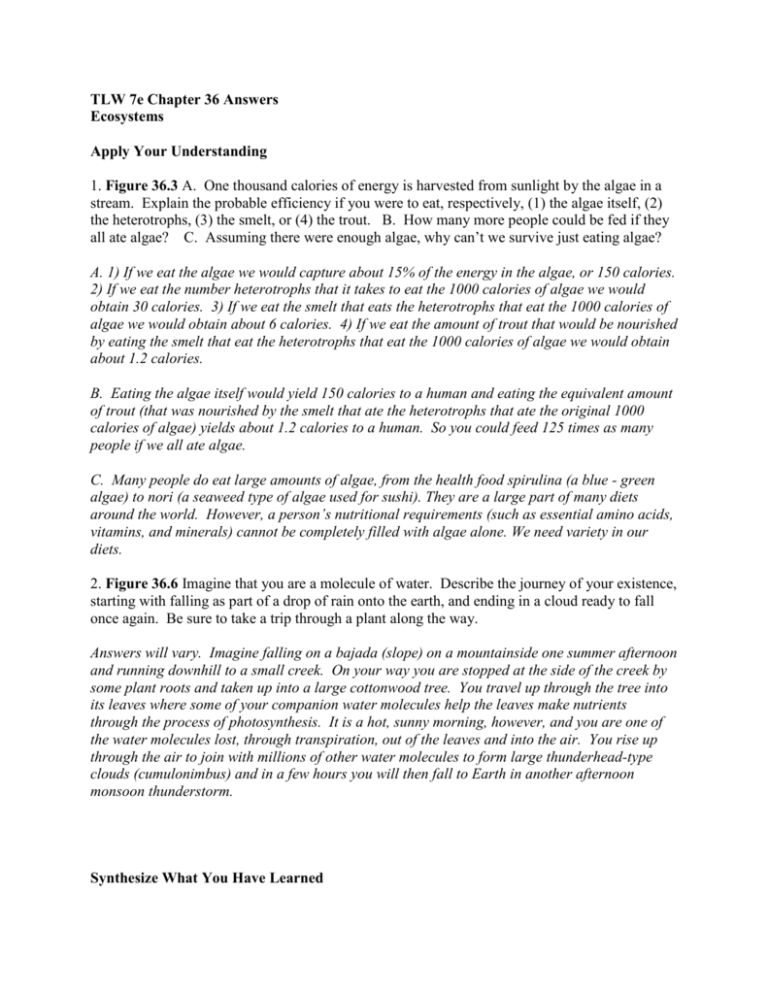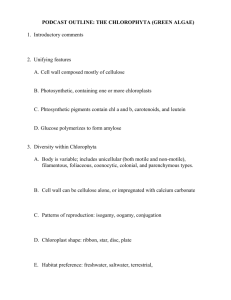TLW 7e Chapter 36 Answers
advertisement

TLW 7e Chapter 36 Answers Ecosystems Apply Your Understanding 1. Figure 36.3 A. One thousand calories of energy is harvested from sunlight by the algae in a stream. Explain the probable efficiency if you were to eat, respectively, (1) the algae itself, (2) the heterotrophs, (3) the smelt, or (4) the trout. B. How many more people could be fed if they all ate algae? C. Assuming there were enough algae, why can’t we survive just eating algae? A. 1) If we eat the algae we would capture about 15% of the energy in the algae, or 150 calories. 2) If we eat the number heterotrophs that it takes to eat the 1000 calories of algae we would obtain 30 calories. 3) If we eat the smelt that eats the heterotrophs that eat the 1000 calories of algae we would obtain about 6 calories. 4) If we eat the amount of trout that would be nourished by eating the smelt that eat the heterotrophs that eat the 1000 calories of algae we would obtain about 1.2 calories. B. Eating the algae itself would yield 150 calories to a human and eating the equivalent amount of trout (that was nourished by the smelt that ate the heterotrophs that ate the original 1000 calories of algae) yields about 1.2 calories to a human. So you could feed 125 times as many people if we all ate algae. C. Many people do eat large amounts of algae, from the health food spirulina (a blue - green algae) to nori (a seaweed type of algae used for sushi). They are a large part of many diets around the world. However, a person’s nutritional requirements (such as essential amino acids, vitamins, and minerals) cannot be completely filled with algae alone. We need variety in our diets. 2. Figure 36.6 Imagine that you are a molecule of water. Describe the journey of your existence, starting with falling as part of a drop of rain onto the earth, and ending in a cloud ready to fall once again. Be sure to take a trip through a plant along the way. Answers will vary. Imagine falling on a bajada (slope) on a mountainside one summer afternoon and running downhill to a small creek. On your way you are stopped at the side of the creek by some plant roots and taken up into a large cottonwood tree. You travel up through the tree into its leaves where some of your companion water molecules help the leaves make nutrients through the process of photosynthesis. It is a hot, sunny morning, however, and you are one of the water molecules lost, through transpiration, out of the leaves and into the air. You rise up through the air to join with millions of other water molecules to form large thunderhead-type clouds (cumulonimbus) and in a few hours you will then fall to Earth in another afternoon monsoon thunderstorm. Synthesize What You Have Learned 1. Given the amount of sunlight that hits the plants on our planet, and the ability of plants for rapid growth and reproduction, explain why we aren’t all hip deep in plants. Plants are continuing to growth and die. Natural and human caused disasters reduce plants and their habitats further limiting plant growth. Remember every parking lot at one time had vegetation on it. Herbivorous insects, parasitic fungi, bacteria, and viruses are all taking “bites” out of plants and the communities that support those plants. Competition for nutrients, space, and water are also limiting the growth of plants. 2. Many experiments by ecologists have shown that species-rich communities are more productive than species-poor ones. If this is so, how is it that American farming, based almost entirely on monocultures, is so productive? Two things – pest control and fertilizer. Tremendous amounts of herbicides and pesticides are used to control weeds and insects that would reduce the yield if left untreated. Enrichment of the soil by the addition. 3. Why do increasing latitude and increasing elevation each affect which plant species grow in a place, and why do the two factors do so in the same way. Depending on your location on the planet you receive the most sunlight possible per unit area near the equator (0 degrees latitude) or some smaller amount as you move closer to the poles (extreme northern and southern latitude). The closer you are to the poles, the sun is very low in the sky even at noon; this means that you receive much smaller amounts of sunlight per unit area. This means more heat in the summer, and warmer winter temperatures, at the equator than at the poles. As you go up a mountain, starting at sea level, it becomes cooler the higher you go. Temperature is strongly related to the types of plants that are able to grow in a particular location. Therefore plants that grow in northern latitudes as a rule can also grow in latitudes closer to the equator at the tops of tall mountains. Similarly, plants that can’t grow in northern latitudes also can’t grow at the tops of tall mountains closer to the equator. Latitude and elevation are related because each one is related to temperature changes. 4. Pick two different biomes that you personally have encountered. Compare and contrast the sunshine, rainfall, major temperature features, and the plants and animals found there. Answers will vary.









